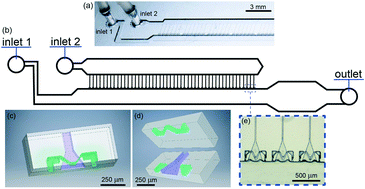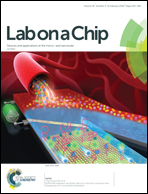Production of monodisperse drops from viscous fluids†
Abstract
Drops are often used as picoliter-sized reaction vessels, for example for high-throughput screening assays, or as templates to produce particles of controlled sizes and compositions. Many of these applications require close control over the size of drops, which can be achieved if they are produced with microfluidics. However, this tight size control comes at the expense of the throughput that is too low for many materials science and almost all industrial applications. To overcome this limitation, different parallelized microfluidic devices have been reported. These devices typically operate at high throughputs if the viscosity of the inner fluid is low. However, fluids that are processed into particles often contain high concentrations of reagents and therefore are rather viscous. We report a microfluidic device containing parallelized triangular nozzles with rectangular cross-sections that can process solutions with viscosities up to 155 mPa s into drops of well-defined sizes and narrow size distributions at significantly higher throughputs than what could be achieved previously. The increased throughput is enabled by the introduction of shunt channels: each nozzle is intersected by shunt channels that facilitate the backflow of the outer phase, thereby increasing the critical rate at which the fluid flow transitions from the dripping into the jetting regime. These modified nozzles open up new possibilities to employ drops made of viscous fluids as templates to produce particles with well-defined sizes for applications that require larger quantities.



 Please wait while we load your content...
Please wait while we load your content...